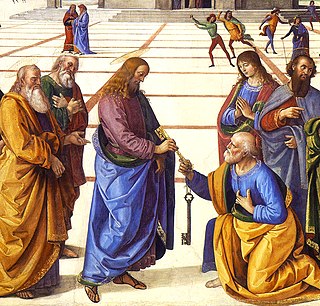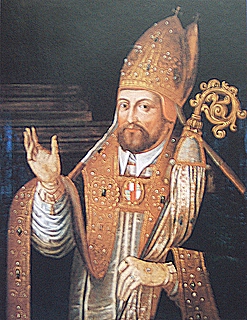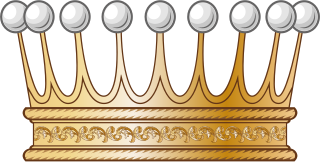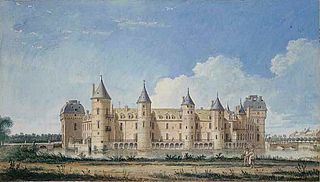
Abbot is an ecclesiastical title given to the male head of a monastery in various western religious traditions, including Christianity. The office may also be given as an honorary title to a clergyman who is not the head of a monastery. The female equivalent is abbess.

A prince-bishop is a bishop who is also the civil ruler of some secular principality and sovereignty. Thus the principality or prince-bishopric ruled politically by a prince-bishop could wholly or largely overlap with his diocesan jurisdiction, since some parts of his diocese, even the city of his residence, could be exempt from his civil rule, obtaining the status of free imperial city. If the episcopal see is an archbishop, the correct term is prince-archbishop; the equivalent in the regular (monastic) clergy is prince-abbot. A prince-bishop is usually considered an elected monarch.
Lord Protector is a title that has been used in British constitutional law for the head of state. It is also a particular title for the British heads of state in respect to the established church. It is sometimes used to refer to holders of other temporary posts, for example, a regent acting for the absent monarch.
Lord is an appellation for a person or deity who has authority, control, or power over others, acting like a master, a chief, or a ruler. The appellation can also denote certain persons who hold a title of the peerage in the United Kingdom, or are entitled to courtesy titles. The collective "Lords" can refer to a group or body of peers.

Count is a historical title of nobility in certain European countries, varying in relative status, generally of middling rank in the hierarchy of nobility. The etymologically related English term "county" denoted the land owned by a count. Equivalents of the rank of count exist or have existed in the nobility structures of some non-European countries, such as hakushaku during the Japanese Imperial era.

Graf (male) or Gräfin (female) is a historical title of the German nobility, usually translated as "count". Considered to be intermediate among noble ranks, the title is often treated as equivalent to the British title of "earl".

The Peerage of France was a hereditary distinction within the French nobility which appeared in 1180 in the Middle Ages, and only a small number of noble individuals were peers. It was abolished in 1789 during the French Revolution, but it reappeared in 1814 at the time of the Bourbon Restoration which followed the fall of the First French Empire, when the Chamber of Peers was given a constitutional function somewhat along British lines, which lasted until the Revolution of 1848. On 10 October 1831, by a vote of 324 against 26 of the Chamber of Deputies, hereditary peerages were abolished, but peerages for the life of the holder continued to exist until the chamber and rank were definitively abolished in 1848.

A coronet is a small crown consisting of ornaments fixed on a metal ring. By one definition, a coronet differs from a crown in that a coronet never has arches, and from a tiara in that a coronet completely encircles the head, while a tiara does not. By a slightly different definition, a crown is worn by an emperor, empress, king or queen; a coronet by a nobleman or lady. See also diadem.

In England, Wales and Ireland a county palatine or palatinate was an area ruled by a hereditary nobleman enjoying special authority and autonomy from the rest of a kingdom or empire. The name derives from the Latin adjective palātīnus, "relating to the palace", from the noun palātium, "palace". It thus implies the exercise of a quasi-royal prerogative within a county, that is to say a jurisdiction ruled by an earl, the English equivalent of a count. A duchy palatine is similar but is ruled over by a duke, a nobleman of higher precedence than an earl or count.
Châtelain was originally the French title for the keeper of a castle.
A bailiff was the king’s administrative representative during the ancien régime in northern France, where the bailiff was responsible for the application of justice and control of the administration and local finances in his bailiwick.

The Diocese of Sion is a Roman Catholic ecclesiastical territory in the canton of Valais, Switzerland. It is the oldest bishopric in the country and one of the oldest north of the Alps. The history of the Bishops of Sion, of the Abbey of St. Maurice of Valais as a whole are inextricably intertwined.

During the Middle Ages, an advocatus was an office-holder who was legally delegated to perform some of the secular responsibilities of a major feudal lord, or for an institution such as an abbey. Especially in the Holy Roman Empire, many such positions developed. Typically, these evolved to include responsibility for aspects of the daily management of agricultural lands, villages and cities. In some regions, advocates were governors of large provinces, sometimes distinguished by terms such as Landvogt.
In Medieval France a paréage or pariage was a feudal treaty recognising joint sovereignty over a territory by two rulers, who were on an equal footing, pari passu; compare peer. On a familial scale, paréage could also refer to the equal division of lands and the titles they brought between sons of an inheritance.

The title of Duke was the highest hereditary title in the French nobility during the time of the monarchy in France.
Liefmann Calmer, lord of Picquigny and vidame (avoué) of Amiens was an important personage in French Jewry of the eighteenth century. His full synagogal name was Moses Eliezer Lipmann ben Kalonymus — in German, "Kallmann," whence the family name "Calmer" is said to have been derived. From "Lipmann" undoubtedly came "Liefmann." Calmer first moved to The Hague, and later left Holland for France, where he made a fortune in commerce and became official purveyor to King Louis XV. In 1769 he obtained French letters of naturalization. He exerted considerable influence in public affairs and became administrator of the "German" Jews in Paris.
Jura regalia is a medieval legal term which denoted rights that belonged exclusively to the king, either as essential to his sovereignty, such as royal authority; or accidental, such as hunting, fishing and mining rights. Many sovereigns in the Middle Ages and in later times claimed the right to seize the revenues of vacant episcopal sees or abbeys, claiming a Regalian right. In some countries, especially in France where it was known as droit de régale, jura regalia came to be applied almost exclusively to that assumed right. A liberty was an area where the regalian right did not apply.
The County of Duras was a medieval county with its seat at the castle of Duras. The 18th century version of this castle still stands and is a part of modern St Truiden in the province of Belgian Limburg. The county was one of several counties in the Hesbaye region which covers the south of Belgian Limburg, and stretches into the neighbouring provinces. The county of Duras itself eventually became part of the County of Loon, and other family titles were inherited by the Counts of Montaigu and Clermont, whose other holdings were further south.

Vidame de Chartres was a title in the French nobility. There are a few vidame titles in France, of which that of Chartres is probably the best known, because a number of holders have been notable in widely different ways over the centuries. Vidame was originally the name for the commander of a bishop's military force in the Early Middle Ages, when bishops, like other great lords, needed troops for security. The title eventually developed into a heritable noble title, like others linked to a specific estate. The title therefore passed to the new owner when the estate was sold, as happened a number of times in this case.












